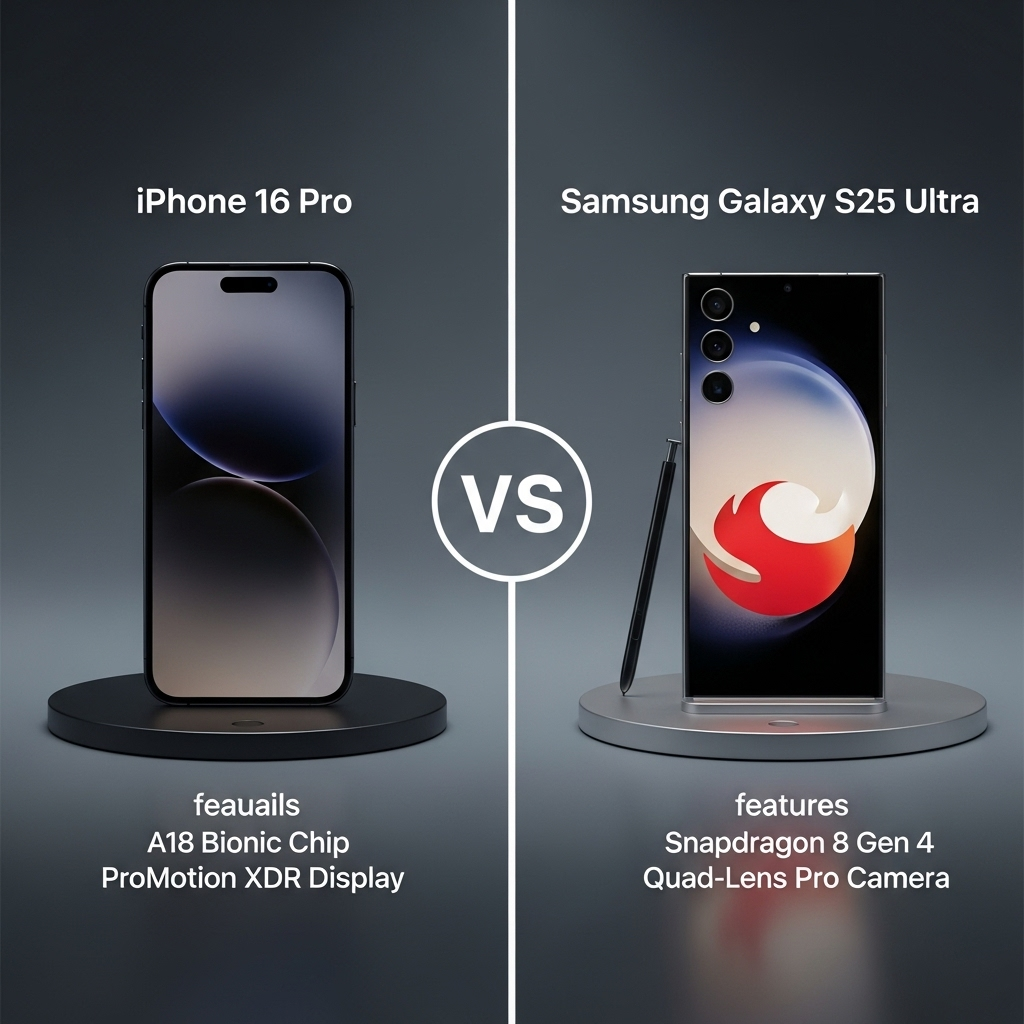Smartphones > iPhone 16 Pro vs. Samsung Galaxy S25 Ultra
Choosing between the iPhone 16 Pro and Samsung Galaxy S25 Ultra means weighing ecosystem preferences against hardware capabilities. Both phones represent the pinnacle of smartphone technology, but cater to different user needs and priorities.
This comparison analyzes real-world performance, user feedback, and key differentiators to help you make an informed decision.
Quick Verdict
The Samsung Galaxy S25 Ultra is the better choice for users who prioritize a larger screen, higher resolution photography, and versatile zoom. The iPhone 16 Pro is ideal for those deeply embedded in the Apple ecosystem who value optimized software and a streamlined user experience.
- The Galaxy S25 Ultra boasts a larger display and higher resolution main camera.
- The iPhone 16 Pro emphasizes computational photography and seamless iOS integration.
- Samsung offers more versatile zoom capabilities with its Quad Tele System.
Who Should Choose Which?
Choose iPhone 16 Pro if:
Apple enthusiasts who appreciate iOS's simplicity, seamless integration with other Apple devices, and a focus on computational photography.
Choose Samsung Galaxy S25 Ultra if:
Users who want the most versatile camera system, a larger display, and the customization options offered by Android.

Key features – Side-by-Side
| Attribute | iPhone 16 Pro | Samsung Galaxy S25 Ultra |
|---|---|---|
| Display Size and Technology | 6.3-inch Super Retina XDR OLED | 6.9-inch Dynamic LTPO AMOLED 2X |
| Processor | Apple A18 Pro chip (3nm) | Snapdragon 8 Elite for Galaxy (3 nm) |
| Main Camera Resolution | 48MP | 200MP |
| Telephoto Capabilities | 12MP, 5x optical zoom | 10MP (3x optical), 50MP (5x optical), Quad Tele System |
| Battery Capacity | 3,582 mAh | 5000 mAh |
| Operating System | iOS 18 | Android 15 with One UI 7 |
Overall Comparison
Pros and Cons
iPhone 16 Pro
- Improved thermal design
- Faster A18 Pro chip
- Optimized ultrawide camera for low-light conditions
- 5x optical zoom telephoto camera
- Sensor-shift optical image stabilization
- iOS 18 personalization features
- Faster 25W MagSafe charging
- Up to 45W charging over USB-C
- No major disadvantages reported.
Samsung Galaxy S25 Ultra
- Exceptional low-light camera performance due to advanced AI features and wider ultrawide aperture.
- Reliable image quality at close and medium zoom ranges with dual optical zoom setup (3x and 5x).
- Long-range zoom is exceptional, especially in bright light.
- Full-day battery life, often extending into the next day, due to 5000mAh battery and software optimizations.
- Durable design with Corning Gorilla Armor 2 on the front and Gorilla Glass Victus 2 on the back, plus titanium frame and IP68 rating.
- Simplified daily tasks with voice commands through Galaxy AI.
- No major disadvantages reported.
User Experiences and Feedback
iPhone 16 Pro
- No highlights reported.
- No major complaints reported.
- No value feedback reported.
Samsung Galaxy S25 Ultra
- No highlights reported.
- No major complaints reported.
- No value feedback reported.
Frequently Asked Questions
Which phone has better low-light camera performance?
The Samsung Galaxy S25 Ultra is expected to have superior low-light performance due to its larger sensor and advanced AI features.
Which phone charges faster?
The iPhone 16 Pro can charge up to 45W over USB-C, potentially offering faster charging speeds than the Galaxy S25 Ultra's 45W wired charging.
Sources & Citations
- Official product specifications
- Expert reviews from tech publications
- User feedback from online forums
Information gathered through AI-assisted web search and analysis. Last updated: October 2025
Methodology & Transparency
Our comparison methodology combines multiple data sources to provide comprehensive, unbiased analysis:
- Data Collection: We gather information from official specifications, user reviews, and independent testing
- AI-Assisted Analysis: Advanced AI helps process large amounts of data while maintaining accuracy
- Human Oversight: All comparisons are reviewed for accuracy and relevance
- Regular Updates: Content is refreshed to reflect new information and user feedback
- Bias Mitigation: We strive for objectivity by considering multiple perspectives and sources
Versusly.ai uses AI-assisted content generation combined with human oversight to deliver comprehensive comparisons. We are transparent about our process and continuously work to improve accuracy and usefulness.